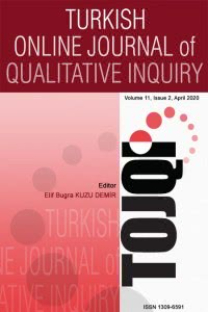Evaluating a Graduate Program of English Language Teacher Education
İngiliz Dili Eğitimi Yüksek Lisans Programı Değerlendirmesi
___
- Baştürkmen, H., & Al-Huneidi, A. (1996).Refining Procedures: A needs analysis project at Kuwait University. (ERIC Document Reproduction Service No: ED413762). Brown, J. D. (1995). The elements of language curriculum. Boston: Heinle and Heinle. Chan, V. (2001). Determining students language needs in a tertiary setting. English Teaching Forum July, 16-27.
- Chia, H., Johnson, R., Chian, H., & Olive, F. (1999). English for college students in Taiwan: A study of perceptions of English needs in a medical context. English for Specific Purposes, 18(2), 107-119.
- Creswell, J. W. (1998). Qualitative inquiry and research design: Choosing among five traditions. Thousand Oaks, CA: Sage Publications. Dolmans, H. J. M., Snellen-Ballendog, H., Wolfhagen, H.A.P., & Vleuten, C.P.M. (1997). Seven principles of effective case design for a problem-based curriculum. Medical Teacher, 19(3), 185-189.
- Dubin, F., & Olshtain, E. (1986). Course design: Developing programs and materials for language learning. New York: Cambridge University Press. Edwards, N. (2000). Language for business: Effective needs assessment, syllabus design and materials preparation in a practical ESP case study. English for Specific Purposes,19, 291-296.
- Ekici, N. (2003). A needs assessment study on English language needs of the tour guidance students of Faculty of Applied Sciences at Başkent University : A Case Study . Unpublished Masters Thesis. Middle East Technical University. Erozan, F. (2005).Evaluating the language improvement courses in the undergraduate ELT curriculum at Eastern Mediterranean University : A case study . Unpublished Masters Thesis. Middle East Technical University.
- Graves, K. (1996). A framework of course development processes. In K. Graves (Ed.), Teachers as course developers (pp. 12-38). Cambridge: Cambridge University Press.
- Henry, A., & Roseberry, R.L. (1999). Raising awareness of the generic structure and linguistic features of essay introductions. Language Awareness, 8(3), 190-200. Hutchinson, T., & Waters, A. (1987).English for specific purposes: A learning centered approach. Cambridge: Cambridge University Press.
- Karataş, H. (2007). Yıldız Teknik Üniversitesi modern diller bölümü İngilizce II dersi öğretim programının öğretmen ve öğrenci görüşlerine göre bağlam, girdi, süreç ve ürün (CIPP) modeli ile değerlendirilmesi. Unpublished Masters Thesis. Yıldız Technical University. Kırmızı, Ö. &Sarıçoban, A. (2013). Choice factors in M.A. ELT programs. Social and Behavioral Sciences Procedia, 70, 282 287.
- Lynch, B. K. (1996). Language program evaluation. Theory and practice. New York: Cambridge University Press. Mede, E. (2012). Design and evaluation of a language preparatory program at an English medium university in an EFL setting : A case study . Unpublished doctoral dissertation. Yeditepe University.
- Muşlu, M. (2007). Formative evaluation of a process-genre writing curriculum at Anadolu university school of foreign language. Unpublished Masters Thesis. Anadolu University.
- Mutlu, Ö. (2004). A needs analysis study for the English-Turkish translation course offered to management students of the faculty of economic and administrative sciences at Başkent University : A case study . Unpublished Masters Thesis. Middle East Technical University. Orkwis, R., & McLane, K. (1998).A curriculum every student can use: Design principles for student access. ERIC/OSEP Special Project. ERIC Clearinghouse on Disabilities and Gifted Education. Council for Exceptional Children. Örs, M. (2006).An analysis of the preparatory students attitudes towards the appropriateness of the preparatory school program at the University of Gaziantep. Unpublished Masters Thesis. University of Gaziantep.
- Özkanal, Ü. (2009). The Evaluation of English preparatory program of Eskişehir Osmangazi University Foreign Languages Department and a model proposal. Unpublished dissertation. Anadolu University. Sarı, R. (2003).A suggested English language teaching program for Gülhane Military Medical Academy . Unpublished Masters Thesis. Middle East Technical University. Stein, M., Carnine, D., & Dixon, R. (1998). Direct instruction: integrating curriculum design and effective teaching practice. Intervention in School and Clinic, 33(4), 227-233.
- Stufflebeam, D. L. (2001). The CIPP model for evaluation. In D. L. Stufflebeam, G. F. Madaus, & T. Kellaghan (Eds.). Evaluation models: Viewpoints on educational and human services evaluation (pp. 279-318).
- Kluwer Academic Publishers. Tarnapolsky, O. (2000). Writing English as a foreign language: A Report from Ukraine. Journal of Second Language Writing, 9(3), 209-226.
- Toker, O. (1999).The attitudes of teaching staff and students towards the preparatory curriculum of the department of foreign languages in the University of Gaziantep. Unpublished Masters Thesis. Gaziantep University.
- Yıldırım, A. & Şimşek, H. (2011). Sosyal Bilimlerde Nitel Araştırma Yöntemleri. Ankara: Seçkin Yayıncılık. Yıldız, Ü. (2004). Evaluation of the Turkish language teaching program for foreigners at Minsk State Linguistic University in Belarus: A case study . Unpublished Masters Thesis. Middle East Technical University.
- ISSN: 1309-6591
- Yayın Aralığı: 4
- Başlangıç: 2010
- Yayıncı: Prof.Dr. Abdullah Kuzu
AHMET NACİ ÇOKLAR, YUSUF LEVENT ŞAHİN
Evaluating a Graduate Program of English Language Teacher Education
Yeşim DOLLAR KESLİ, Aylin TOLU TEKİNER, FEYZA DOYRAN
Öğrencilerin Gözüyle Teknoloji Okuryazarlığı: Nedir, Neredeyiz, Aile ve Çocuklar İçin Neler Yapmalı?
Yusuf Levent ŞAHİN, Ahmet Naci COKLAR
Abdullah KUZU, SERKAN ÇANKAYA, Atilla CAVKAYTAR, H. Ferhan ODABAŞI, SUZAN DUYGU ERİŞTİ
